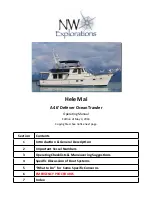
10
How to fold a sailing propeller into sailing position
First thing is to make sure weather you have a mechanical or hydraulic transmission. HR 310, 342, 372
and 37 have mechanical transmission. HR 40 and larger have hydraulic transmission.
If you have mechanical transmission:
When sailing: Stop the engine. It doesn’t matter in what position the throttle lever is. When the engine
is stopped, take the throttle to reverse position. Now the propeller is in sailing position. Take the
throttle back to neutral, so that the engine can be started up quickly, in case you should need to do so.
The procedure for a hydraulic transmission is completely different:
First method: While the engine is still running, give so much gas that the propeller is pushing the boat
forward 4 knots more than the sails are. Switch the engine off without moving the gas throttle. You will
hear how the propeller folds together and the shaft is no longer moving. Then put the throttle back in
neutral, so the engine may be started up quickly if you should need to do so.
The second one is more reliable but requires more feel: While the engine is still running, put the gas
lever in reverse, but only just so much that you hear that the reverse starts to work, not more. Switch
the engine off without moving the gas throttle. You will hear how the propeller folds together and the
shaft is no longer moving. Then put the throttle back in neutral, so the engine may be started up
quickly if you should need to do so.
The above procedures are for all sailing propellers, no matter the make.
To try to install a shaft brake is definitely something that we do not recommend and is also
unnecessary.
Filling of water- and Diesel tanks
The tank gauge on the instrument panel shows the approximate level in the tank. All tank sensors,
especially in water tanks, can however be affected by errors and the fact that the tanks are not cubic
shaped and the readings should only be taken as a rough measure.
The tanks are provided with plugs for manual sounding. The sounding is done with a dipstick.
Wet the teak deck with water before opening the deck fill to avoid discolouring by the almost
unavoidable diesel drops.
If you want to fill up to full capacity of the tank, do not rely on the tank meter! Use the plug and a dip
stick.
Do NOT overdo the tightening of the cap. A little water respectively diesel oil on the gasket in the
cap will prevent damage.
Never risk running the tank empty. First of all a dangerous situation may develop.
Second it can be complicated to vent the fuel system to get the air out of the injection pumps and
nozzles. In spite of self priming qualities this is a problem that should be avoided at all times.
If it should happen: consult the engine manual.
Environment protection
Water tanks can be filled until they overflow on deck. This must not happen with
diesel. Oil spill is forbidden!! Do not overfill!
Summary of Contents for HR 310
Page 1: ...Instruction Book All models 2013 2014...
Page 13: ...13 Drawing of Diesel system Hallberg Rassy 310 342 40 43...
Page 14: ...14 Drawing of Diesel system Hallberg Rassy 412...
Page 15: ...15 Drawing of Diesel system Hallberg Rassy 48 55 and 64...
Page 25: ...25 Fresh water system Hallberg Rassy 372 and 412...
Page 42: ...42 Adjustment of hinges for locker doors...
Page 43: ...43...
Page 44: ...44...
Page 50: ...50 Hallberg Rassy 372 Standard Through hull fittings overview...
Page 51: ...51 Hallberg Rassy 412 Through hull fittings overview Continued on next page...
Page 52: ...52 Hallberg Rassy 412 Through hull fittings overview...
Page 60: ...60 D A T A...











































